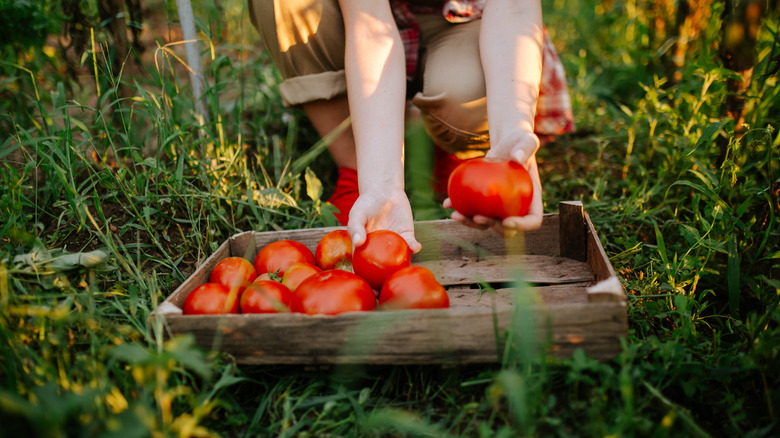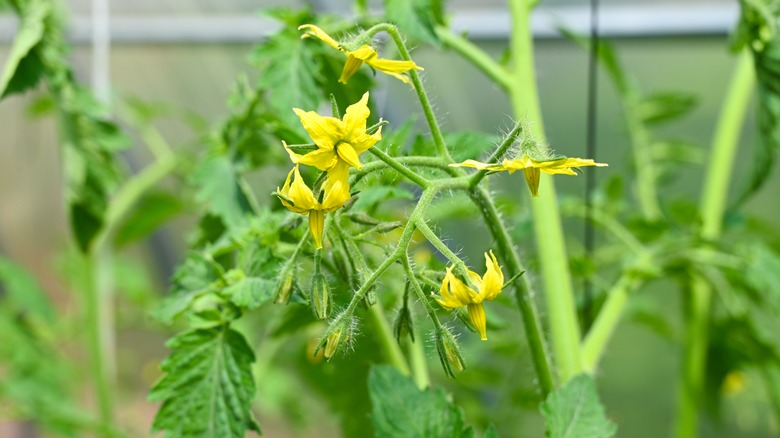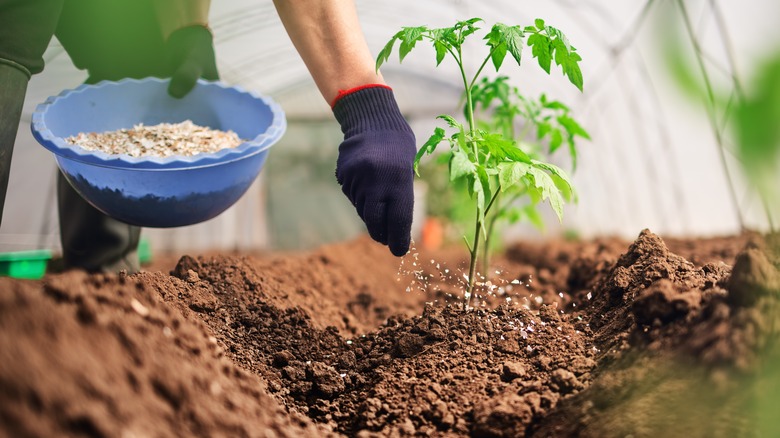Why Your Tomato Plants Aren't Producing Fruit (& What To Do About It)
Tomato plants are popular in home gardens across the United States. This probably comes as no surprise, as they are rich in antioxidants like lycopene and vitamin C and nutrients including folate, potassium, and iron — not to mention that they're delicious when added to a number of different meals. These self-pollinating plants are an easy choice for novice gardeners with small spaces, since each bloom has both male and female parts. Tomato plants produce small yellow flowers which fade away to develop tasty fruit. You may notice that some flowers open but don't produce a tomato. This can happen when periods extreme heat or heavy rain prevent the plant from producing enough pollen or it gets washed off the blooms before they are fertilized.
Pouring time and energy into plants that cannot thrive is frustrating. To avoid this, it's imperative to get to the root of the problem (pun intended). There are quite a few reasons why you may not be growing the best tomatoes, or any tomatoes at all, in your garden. Your plant may simply need may need more sun or water, or the problem may be more extensive. Sometimes high temperatures or periods of drought can cause a plant to temporarily stop producing flowers, while too much nitrogen in the soil can lead to big, bushy plants that don't produce fruit. Let's take a closer look at how the environment impacts your home garden and what you can do to encourage healthy tomato plants.
Extreme temperatures nip tomato production in the bud
Many forms of vegetation are highly sensitive to shifting temperatures. Tomatoes grow best at 70 to 80 degrees Fahrenheit during the day, and the plants experience heat stress when temperatures rise to between 86 and 104 degrees Fahrenheit. Heat stress causes issues in reproduction by limiting the amount of pollen that's produced and released in the male portion of the flower, called the stamen. Since the amount of pollen that's produced and released is limited, the tomato cannot be pollinated and will not grow fruit. Sometimes blooms are only partially fertilized, resulting in undersized fruits that may not mature.
Fortunately, there are things you can do to beat the heat. One garden hack for growing tomatoes is to mulch your soil. The mulch adds a protective covering for garden soil, keeping it cooler and reducing evaporation. You can also cover your plants with shade cloth during periods of extreme heat. You don't want to completely block the sun from your plants, so select an option that provides 30 to 50% shade to protect existing fruits from sunscald and keep your plants and the ground a little cooler. If you suspect your plants are not producing fruit because they aren't being sufficiently pollinated, you can try to hand pollinate your plants as well.
Nitrogen-rich soil stalls fruit on tomato plants
Too much nitrogen in your garden soil is another hindrance to tomato plants producing fruit. High levels are tricky to diagnose at first because tomato plants look exceptionally lush. Unfortunately, the same macronutrient that's causing your plant to flourish may also be stalling fruit production. Using exorbitant amounts of fertilizer is sometimes the culprit in these predicaments. The best way to find out if there is an imbalance in the nutrients in your soil is by getting a soil test. You can purchase a DIY kit or contact your local extension service can help you grow a gorgeous garden. It's better to under fertilize than use too much, but if your nitrogen levels are already excessive, planting nitrogen-hungry plants, like leafy greens, in that spot next year can lower the levels.
To manage nitrogen levels in the future, get a soil test every year or so. It's also best to use a fertilizer specifically made for tomatoes, which is why knowing what NPK fertilizer is and why it is important for keeping your plants healthy. For example, a good option would be a bag with the ratio 5-10-18 which represents the levels of nitrogen, phosphorus, and potassium. The best fertilizer for healthy tomatoes should have a low nitrogen level to avoid excessive green growth and a higher potassium level to encourage fruit production.


